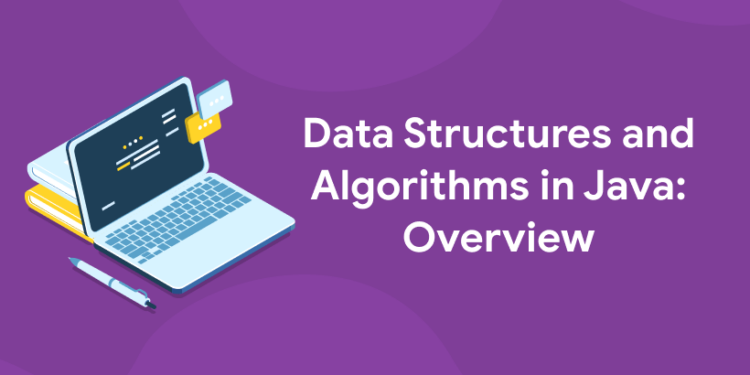Table of Contents
Data structures and algorithms are among the most important elements of any computer science program, and you’ll need to understand them in order to be able to write good programs yourself. This guide provides an overview of some of the most fundamental linear data structures and algorithms that you’ll need to know in Java, including how they’re implemented and what their uses are, as well as links to more detailed information about each structure or algorithm if you want to learn more about them. Java provides many useful data structures and algorithms that you can use in your programs to increase their efficiency. In this article, we’ll examine the top data structures and algorithms in Java, so you can use them in your programs as well! Each section provides an overview of the algorithm or data structure as well as some code to demonstrate how it works. After reading this article, you should have a better understanding of what each of this linear data structure and algorithms is capable of, and you’ll know when to use them in your own programs! Java has been around in the programming world for over 20 years, and it shows no signs of slowing down. In this article, we are going to be looking at the top 10 data structures and algorithms that every Java developer should know when coding up an application. So, let’s get started!…
1) Lists
Lists are very versatile data structures, used for storing values of any type. The most common form is a list of integers, but they can store real numbers, strings, or anything else you want. A linked list is a variation on a normal list that stores its values as separate objects instead of having them be part of one long array. This makes linked lists excellent for recursive algorithms that need to save their place when making calculations (such as Towers of Hanoi). Linked lists also provide random access to individual elements; with an ordinary array, you’d have to loop through all preceding values before you could get to a particular element. As far as complexity goes, it’s worth noting that adding new items to a linked list requires more steps than adding items to an array since each value needs to be set up separately. However, finding specific values in a linked list is faster than doing so with arrays because there’s no need to search through every value first. Because of these trade-offs between space and time efficiency, using lists depends on your applications of data structure: if you’re going for space efficiency then use arrays; if speed is more important then use linked lists.
Learn to code from industry experts! Enroll here!
2) Stacks
1: What is the default value of a boolean in Java?
A stack is a data structure that operates based on LIFO (Last In First Out) principle. The most recent item is always at the top of the stack and all other items are stacked below it. This means that as you pop each item from a stack, it will be removed from top to bottom. A stack can also hold multiple objects of different types but when removing an object, you must take them all out of a stack individually because objects are removed one at a time, similar to using an array. We cannot remove just one element because we would not know where exactly to start (as for an array). Stacks are mostly used in applications of data structure such as parsing, compiling, or evaluating expressions. They can also be used to store frequently accessed data and programs. Stacks are typically implemented as arrays or linked lists which allows them to perform O(1) operations for adding/removing elements but O(n) operations for finding elements by index. A very simple example of Stack is any to-do list. You write down tasks one after another and keep working until there’s nothing left to do. Once you’re done, you take off the task list so no new tasks can be added. However, if someone else comes along and wants to add a new task they have to put it at the end of your list since everything was already taken care of by previous people who were working on your project.
Explore Free Coding Courses !
Take your first step toward mastering in-demand skills, acing interviews, and securing top-tier jobs with Entri's free coding courses.
👉 Explore Free Courses Now3) Queues
A queue is a First-In-First-Out (FIFO) data structure, meaning that items added to a queue are removed from it in the last-in-first-out order. This can be compared to a standard queue of people at an airport or grocery store; once you get into the line, you move up to the front of it each time someone else is served. A useful real-world analogy for these structures involves using them as a simple implementation of multi-producers/multi consumers architecture. This can be done by having multiple threads add to a FIFO, while other threads consume data out of it. The result will be that all of your threads will have equal access to resources because they’re all able to retrieve data simultaneously. The Queue interface was introduced in JDK 1.2 and contains two main methods: add(E e), which adds an element to the end of the queue, and remove(), which removes and returns an element from anywhere within it. You also have to peek(), which lets you look at elements without removing them, but you don’t know where they came from—it’s like looking through a window on top of a stack instead of being able to reach in yourself.
Learn to code from industry experts! Enroll here!
4) Trees
Trees are linear data structure that allow you to store hierarchical data. The most important thing to know about trees is that they’re acyclic. That means it’s impossible for any branch to loop back on itself (like a cyclic graph does). A sample tree is shown below A binary search tree allows you to find a value quickly by comparing it with its neighbors. To do so, compare your value with each neighbor until you find one that’s greater than or equal to your value; then, go up from there. For example, if we were looking for 5 in our sample tree above, we would first compare 5 with 4 (since 5 > 4) and find out that 5 isn’t in our current subtree—we would then follow our parent pointer up until we reach 3 as our root node: 5 > 4 > 2 > 3.
5) Graphs
A graph is a structure that consists of vertices (nodes) and edges connecting these nodes. The edges may be unidirectional, i.e., from one node to another, or bidirectional, connecting two nodes to each other. One more possible variation is self-loops where an edge connects a node to itself. A directed graph has nodes with distinct IDs and no edge may connect two nodes having equal IDs. Nodes are often called vertices for short. An undirected graph has no such restriction on its edges: any two given nodes can be connected by an edge even if they have equal IDs. In a weighted graph, every edge also carries a weight that indicates how costly it is to traverse it. Often we assume all weights are nonnegative numbers and sum up to 1 (or 100%). Two graphs are said to be isomorphic if there exists a bijection between their sets of nodes and their sets of edges such that both graphs have exactly one node connected to any given node and exactly one edge between any pair of given nodes.
Learn to code from industry experts! Enroll here!
Explore Free Coding Courses !
Take your first step toward mastering in-demand skills, acing interviews, and securing top-tier jobs with Entri's free coding courses.
👉 Explore Free Courses Now6) Sets
The union of two sets A and B is denoted by A B. Union means to find all elements which are contained in either set A or set B. Write a Java program that gives two input sets A1, B1, and computes their union. Set theory is used extensively throughout computer science, particularly within areas such as relational databases and information retrieval. This post will introduce you to three different types of set: finite or countable sets (e.g., all subsets of a given finite-size set), finite but uncountable sets (e.g., real numbers), and infinite but countable sets (e.g., integers). Finite Sets Finite sets can be defined formally using set-builder notation. For example, {0, 1} denotes the set containing 0 and 1; {x : x is an even number} denotes the set containing all even numbers; and so on. In addition to being able to define finite sets via set-builder notation, we can also use mathematical operations on them. For example, if S = {2, 4}, then 2 + S = {2, 4}, 2 – S = {0}, 2 * S = {0}. Defining operations for finite sets allows us to perform operations on them just like we would with any other algebraic structure like integers or polynomials.
7) Hash Tables/Dictionaries
At first glance, it might seem like there’s a whole lot to know about hash tables/dictionaries (hash maps). Luckily, they’re actually easy to use! How do they work? What’s up with all those performance tests floating around? Just how do you go about using them? To answer all these questions and more, let’s take a closer look at data structures for fast lookup. This is an overview of my personal favorite data structure: Hash Tables/Dictionaries. The following are my top 10 favorite things about Hash Tables/Dictionaries: [INSERT TOP TEN LIST HERE] Let’s talk about one of my favorites: Concurrency issues. Yes, you can share access to the hash table between threads and yes, that does make your code more complex than just using a regular array. However, modern programming languages have thread-safe collections which will help keep your sanity if your app has multiple threads running at once or if it allows users to interact with each other online through your app; both scenarios require concurrent programming techniques which can be achieved by sharing access to objects between threads safely.
8) Bit Manipulation
Bit manipulation refers to any operation done on bits individually. A bit is a single binary digit that can have a value of either 0 or 1. Usually, operations on bits are performed with variables of type byte, short, or int depending on their size. Note that bytes are not variables but rather wrappers around an integer between -128 and 127; they cannot store negative values. This post has examples of how you can use bit manipulation to create a random password generator. To create such a generator, you must first understand what makes up a random password (or at least understand how one might look if created randomly). The most important element of any password is its length; for optimal security for most applications of data structure, your password should be at least 12 characters long and contain no repeated characters. It should also include numbers, symbols, and upper- and lowercase letters. Using these requirements as a guide, we can start creating our random password generator by using bit manipulation to generate all possible combinations of a string consisting of letters, numbers, symbols, and spaces. We’ll start by generating all possible combinations of only letters using bitwise AND operators: abcdefghijklmnopqrstuvwxyzABCDEFGHIJKLMNOPQRSTUVWXYZ. By doing so we get 26 x 26 = 676 possibilities.
9) Sorting Algorithms
We all use sorting algorithms every day. From computer files to applications of data structure on our smartphones to elements of a PowerPoint presentation, data is organized for easy access. If we want to sort by name or date, alphabetically or chronologically, we use a sorting algorithm. The three most common kinds of sorting algorithms are Merge Sort, Quick Sort, and Heap Sort. For example, if you have 50 items that need to be sorted and arranged from least value to greatest value (decreasing), starting with A as your first letter and ending with Z as your last letter—you would first use either a Merge Sort or Quick Sort algorithm to do so efficiently; otherwise, you’d run out of time sorting through all 50 elements by hand. Each of these algorithms has its own advantages and disadvantages. Mergesort requires O(n log n) time to complete while Quick Sort requires O(n) time but it also uses more memory than Merge Sort because it must store everything in memory until it sorts them. On average, both require about O(n log n) performance but they each handle different sizes better than others depending on how they work internally. HeapSort uses less memory than both merge sort and quick sort because it doesn’t need to keep everything in memory at once but instead builds a heap (or stack). It then removes one element at a time from the top of that heap until everything else is neatly sorted. Since it’s not using nearly as much memory, it performs faster too!
10) Searching/Filtering Algorithms
A search or filtering algorithm is one that allows you to search for an element within a data structure. For example, consider searching a list for a name. The particular method you use depends on what your goal is. If you want to print all elements of a data structure, you will use different algorithms than if you want to know where they are located or whether they exist at all. You will also need to choose different algorithms if searching is just one of several operations that have to be done with data. While there are many variations of these algorithms, we can classify them into two main categories: linear data structure. Linear time means that it takes about constant time (i.e., O(1)) to execute an operation whereas logarithmic time means that it takes about logarithmic time (i.e., O(log n)). In other words, linear data structure take more steps to complete their tasks but each step is simple while logarithmic ones take fewer steps but each step requires more processing power from our computer’s CPU. Searching/Filtering Algorithms: A search or filtering algorithm is one that allows you to search for an element within a data structure. For example, consider searching a list for a name. If you are interested to learn new coding skills, the Entri app will help you to acquire them very easily. Entri app is following a structural study plan so that the students can learn very easily. If you don’t have a coding background, it won’t be any problem. You can download the Entri app from the google play store and enroll in your favorite course.










